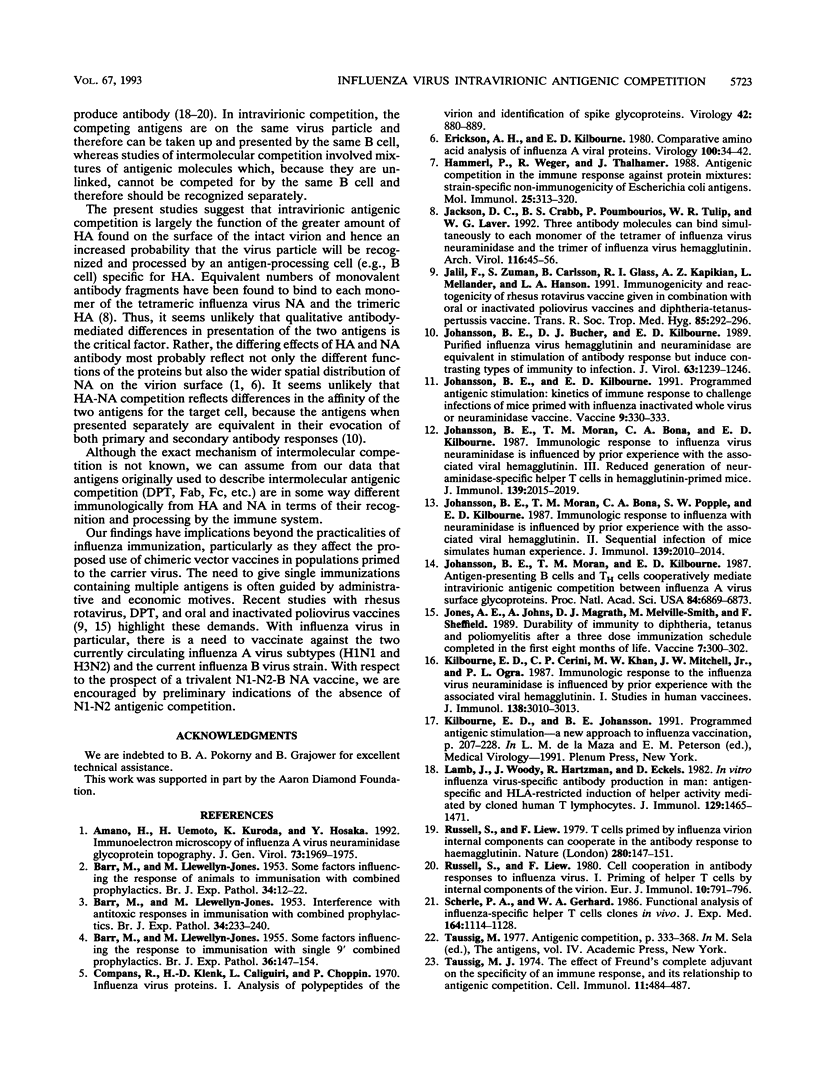Abstract
When presented together on the intact influenza virus particle, the external hemagglutinin (HA) and neuraminidase (NA) antigens are competitive, with HA dominant over NA in both T- and B-cell priming (B. E. Johansson, T. M. Moran, and E. D. Kilbourne, Proc. Natl. Acad. Sci. USA 84:6869-6873, 1987). Dissociation and purification of HA and NA from virus and their injection separately or in combination into BALB/c mice eliminates their antigenic competition as measured by antibody response, confirming that it is their structural association that leads to what we have termed intravirionic antigenic competition. We discuss this phenomenon with respect to previously described intermolecular antigenic competition and with regard to its probable mechanism. Our findings are relevant to contemporary interest in viral vaccine vectors and multicomponent vaccines.
Full text
PDF


Selected References
These references are in PubMed. This may not be the complete list of references from this article.
- Amano H., Uemoto H., Kuroda K., Hosaka Y. Immunoelectron microscopy of influenza A virus neuraminidase glycoprotein topography. J Gen Virol. 1992 Aug;73(Pt 8):1969–1975. doi: 10.1099/0022-1317-73-8-1969. [DOI] [PubMed] [Google Scholar]
- BARR M., LLEWELLYN-JONES M. Interference with antitoxic responses in immunisation with combined prophylactics. Br J Exp Pathol. 1953 Jun;34(3):233–240. [PMC free article] [PubMed] [Google Scholar]
- BARR M., LLEWELLYN-JONES M. Some factors influencing the response of animals to immunisation with combined prophylactics. Br J Exp Pathol. 1953 Feb;34(1):12–22. [PMC free article] [PubMed] [Google Scholar]
- BARR M., LLEWELLYN-JONES M. Some factors influencing the response to immunisation with single and combined prophylactics. Br J Exp Pathol. 1955 Apr;36(2):147–154. [PMC free article] [PubMed] [Google Scholar]
- Compans R. W., Klenk H. D., Caliguiri L. A., Choppin P. W. Influenza virus proteins. I. Analysis of polypeptides of the virion and identification of spike glycoproteins. Virology. 1970 Dec;42(4):880–889. doi: 10.1016/0042-6822(70)90337-5. [DOI] [PubMed] [Google Scholar]
- Erickson A. H., Kilbourne E. D. Comparative amino acid analysis of influenza A viral proteins. Virology. 1980 Jan 15;100(1):34–42. doi: 10.1016/0042-6822(80)90549-8. [DOI] [PubMed] [Google Scholar]
- Hammerl P., Weger R., Thalhamer J. Antigenic competition in the immune response against protein mixtures: strain-specific non-immunogenicity of Escherichia coli antigens. Mol Immunol. 1988 Mar;25(3):313–320. doi: 10.1016/0161-5890(88)90023-5. [DOI] [PubMed] [Google Scholar]
- Jackson D. C., Crabb B. S., Poumbourios P., Tulip W. R., Laver W. G. Three antibody molecules can bind simultaneously to each monomer of the tetramer of influenza virus neuraminidase and the trimer of influenza virus hemagglutinin. Arch Virol. 1991;116(1-4):45–56. doi: 10.1007/BF01319230. [DOI] [PubMed] [Google Scholar]
- Jalil F., Zaman S., Carlsson B., Glass R. I., Kapikian A. Z., Mellander L., Hanson L. A. Immunogenicity and reactogenicity of rhesus rotavirus vaccine given in combination with oral or inactivated poliovirus vaccines and diphtheria-tetanus-pertussis vaccine. Trans R Soc Trop Med Hyg. 1991 Mar-Apr;85(2):292–296. doi: 10.1016/0035-9203(91)90061-3. [DOI] [PubMed] [Google Scholar]
- Johansson B. E., Bucher D. J., Kilbourne E. D. Purified influenza virus hemagglutinin and neuraminidase are equivalent in stimulation of antibody response but induce contrasting types of immunity to infection. J Virol. 1989 Mar;63(3):1239–1246. doi: 10.1128/jvi.63.3.1239-1246.1989. [DOI] [PMC free article] [PubMed] [Google Scholar]
- Johansson B. E., Kilbourne E. D. Programmed antigenic stimulation: kinetics of the immune response to challenge infections of mice primed with influenza inactivated whole virus or neuraminidase vaccine. Vaccine. 1991 May;9(5):330–333. doi: 10.1016/0264-410x(91)90059-f. [DOI] [PubMed] [Google Scholar]
- Johansson B. E., Moran T. M., Bona C. A., Kilbourne E. D. Immunologic response to influenza virus neuraminidase is influenced by prior experience with the associated viral hemagglutinin. III. Reduced generation of neuraminidase-specific helper T cells in hemagglutinin-primed mice. J Immunol. 1987 Sep 15;139(6):2015–2019. [PubMed] [Google Scholar]
- Johansson B. E., Moran T. M., Bona C. A., Popple S. W., Kilbourne E. D. Immunologic response to influenza virus neuraminidase is influenced by prior experience with the associated viral hemagglutinin. II. Sequential infection of mice simulates human experience. J Immunol. 1987 Sep 15;139(6):2010–2014. [PubMed] [Google Scholar]
- Johansson B. E., Moran T. M., Kilbourne E. D. Antigen-presenting B cells and helper T cells cooperatively mediate intravirionic antigenic competition between influenza A virus surface glycoproteins. Proc Natl Acad Sci U S A. 1987 Oct;84(19):6869–6873. doi: 10.1073/pnas.84.19.6869. [DOI] [PMC free article] [PubMed] [Google Scholar]
- Jones A. E., Johns A., Magrath D. I., Melville-Smith M., Sheffield F. Durability of immunity to diphtheria, tetanus and poliomyelitis after a three dose immunization schedule completed in the first eight months of life. Vaccine. 1989 Aug;7(4):300–302. doi: 10.1016/0264-410x(89)90189-8. [DOI] [PubMed] [Google Scholar]
- Kilbourne E. D., Cerini C. P., Khan M. W., Mitchell J. W., Jr, Ogra P. L. Immunologic response to the influenza virus neuraminidase is influenced by prior experience with the associated viral hemagglutinin. I. Studies in human vaccinees. J Immunol. 1987 May 1;138(9):3010–3013. [PubMed] [Google Scholar]
- Lamb J. R., Woody J. N., Hartzman R. J., Eckels D. D. In vitro influenza virus-specific antibody production in man: antigen-specific and HLA-restricted induction of helper activity mediated by cloned human T lymphocytes. J Immunol. 1982 Oct;129(4):1465–1470. [PubMed] [Google Scholar]
- Russell S. M., Liew F. Y. Cell cooperation in antibody responses to influenza virus. I. priming of helper t cells by internal components of virion. Eur J Immunol. 1980 Oct;10(10):791–796. doi: 10.1002/eji.1830101013. [DOI] [PubMed] [Google Scholar]
- Russell S. M., Liew F. Y. T cells primed by influenza virion internal components can cooperate in the antibody response to haemagglutinin. Nature. 1979 Jul 12;280(5718):147–148. doi: 10.1038/280147a0. [DOI] [PubMed] [Google Scholar]
- Scherle P. A., Gerhard W. Functional analysis of influenza-specific helper T cell clones in vivo. T cells specific for internal viral proteins provide cognate help for B cell responses to hemagglutinin. J Exp Med. 1986 Oct 1;164(4):1114–1128. doi: 10.1084/jem.164.4.1114. [DOI] [PMC free article] [PubMed] [Google Scholar]
- Taussig M. J. The effect of Freund's complete adjuvant on the specificity of an immune response, and its relationship to antigenic competition. Cell Immunol. 1974 Mar 30;11(1-3):484–487. doi: 10.1016/0008-8749(74)90046-x. [DOI] [PubMed] [Google Scholar]


